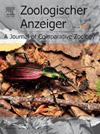Ecological and biogeographic drivers of speciation in neotropical hognose pit vipers, Porthidium (Squamata, Viperidae)
IF 1.5
3区 生物学
Q2 ZOOLOGY
引用次数: 0
Abstract
The neotropical hognose pit vipers (Porthidium) represent an ideal system for studying how ecological and geographic factors drive speciation. This genus encompasses nine species distributed across diverse environments in North, Central and northern South America, with two distinct clades suggesting historical ecological differentiation. Using a time-calibrated phylogeny and occurrence data, we tested whether speciation was driven by niche conservatism or divergence, and assessed the role of major biogeographic barriers. Niche overlap analyses revealed no or low similarity between species (mean D = 0.12, I = 0.24, Jaccard full background = 0.02 and Jaccard union background = 0.06). Our null models confirm an indistinct niche overlap between sister species and random species, indicating speciation through ecological divergence. Speciation was shaped by three major barriers: the Nicaraguan Depression (∼10 Mya), the Motagua-Polochic Fault (∼7.7 Mya), and the Isthmus of Tehuantepec (∼3.1–3.5 Mya) indicating an ancestral range in the Pacific dominion by all models, while additionally Páramo and Yucatan Peninsula province by the Bayesian approach. Our findings demonstrate that Porthidium speciation was driven by niche divergence rather than conservatism, with geographic barriers promoting parapatric speciation for non-endemic Porthidium species and sympatric speciation for endemic species. This integrated framework provides new insights into how ecological adaptation and physical barriers interact during rapid radiations in Neotropical vertebrates.
新热带猪鼻蝮蛇物种形成的生态和生物地理驱动因素(鳞目,蛇科)
新热带猪鼻蝮蛇(Porthidium)是研究生态和地理因素如何驱动物种形成的理想系统。该属包括9种,分布在北美洲、中美洲和南美洲北部的不同环境中,有两个不同的分支,表明历史上的生态分化。利用时间校准的系统发育和发生数据,我们测试了物种形成是由生态位保守性还是分化驱动的,并评估了主要生物地理障碍的作用。生态位重叠分析结果显示物种间无相似性或相似性较低(平均D = 0.12, I = 0.24, Jaccard全背景= 0.02,Jaccard联合背景= 0.06)。我们的零模型证实姐妹物种和随机物种之间存在模糊的生态位重叠,表明物种通过生态分化形成。物种形成受到三个主要障碍的影响:尼加拉瓜洼地(~ 10万年前)、莫塔瓜-波洛奇断层(~ 7.7万年前)和特万特佩克地峡(~ 3.1-3.5万年前),所有模型都表明它们的祖先范围在太平洋地区,而贝叶斯方法还表明Páramo和尤卡坦半岛省。研究结果表明,该物种的形成是由生态位分化而非保守性驱动的,地理屏障促进了非特有种的异域种形成和特有种的同域种形成。这一综合框架为新热带脊椎动物在快速辐射过程中生态适应和物理屏障如何相互作用提供了新的见解。
本文章由计算机程序翻译,如有差异,请以英文原文为准。
求助全文
约1分钟内获得全文
求助全文
来源期刊

Zoologischer Anzeiger
生物-动物学
CiteScore
2.80
自引率
7.10%
发文量
75
审稿时长
>12 weeks
期刊介绍:
Zoologischer Anzeiger - A Journal of Comparative Zoology is devoted to comparative zoology with a special emphasis on morphology, systematics, biogeography, and evolutionary biology targeting all metazoans, both modern and extinct. We also consider taxonomic submissions addressing a broader systematic and/or evolutionary context. The overall aim of the journal is to contribute to our understanding of the organismic world from an evolutionary perspective.
The journal Zoologischer Anzeiger invites suggestions for special issues. Interested parties may contact one of the editors.
 求助内容:
求助内容: 应助结果提醒方式:
应助结果提醒方式:


